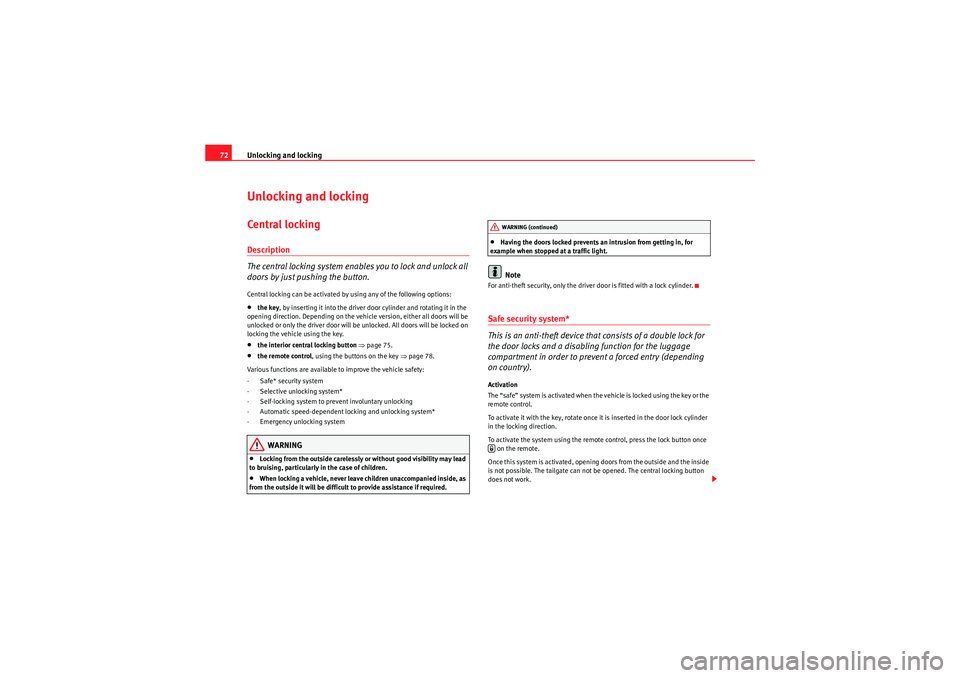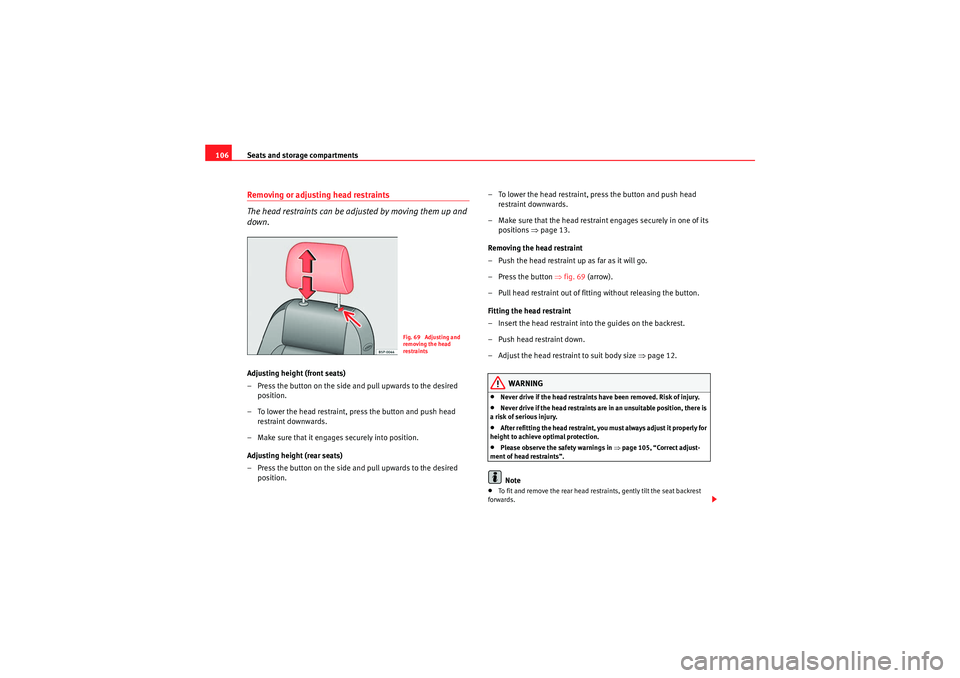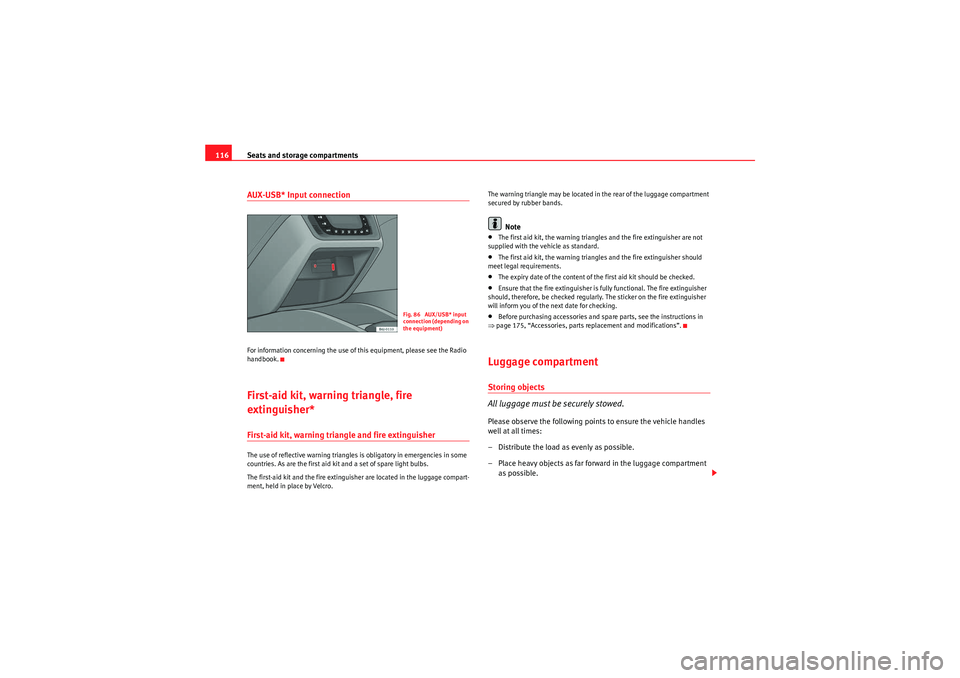2010 Seat Ibiza 5D ECU
[x] Cancel search: ECUPage 74 of 266

Unlocking and locking
72Unlocking and lockingCentral l ocking Description
The central locking system enables you to lock and unlock all
doors by just pushing the button.Central locking can be activated by using any of the following options:•the key , by inserting it into the driver door cylinder and rotating it in the
opening direction. Depending on the vehicle version, either all doors will be
unlocked or only the driver door will be unlocked. All doors will be locked on
locking the vehicle using the key.•the interior central locking button ⇒ page 75.•the remote control , using the buttons on the key ⇒ page 78.
Various functions are available to improve the vehicle safety:
- Safe* security system
- Selective unlocking system*
- Self-locking system to prevent involuntary unlocking
- Automatic speed-dependent locking and unlocking system*
- Emergency unlocking systemWARNING
•Locking from the outside carelessly or without good visibility may lead
to bruising, particularly in the case of children.•When locking a vehicle, never leave children unaccompanied inside, as
from the outside it will be difficult to provide assistance if required.
•Having the doors locked prevents an intrusion from getting in, for
example when stopped at a traffic light.Note
For anti-theft security, only the driver door is fitted with a lock cylinder.Safe security system*
This is an anti-theft device that consists of a double lock for
the door locks and a disabling function for the luggage
compartment in order to prevent a forced entry (depending
on country).Activation
The “safe” system is activated when the vehicle is locked using the key or the
remote control.
To activate it with the key, rotate once it is inserted in the door lock cylinder
in the locking direction.
To activate the system using the remote control, press the lock button once on the remote.
Once this system is activated, opening doors from the outside and the inside
is not possible. The tailgate can not be opened. The central locking button
does not work.
WARNING (continued)
Ibiza_EN.book Seite 72 Mittwoch, 1. September 2010 5:24 17
Page 77 of 266

Unlocking and locking75
Safety First
Operating Instructions
Practical Tips
Technical Specifications
Central locking button*
The central locking button allows you to lock and unlock the
vehicle from the inside.Locking the vehicle
– Press button ⇒fig. 41 ⇒ .
Unlocking the doors
– Press the button ⇒fig. 41 .The central locking button is still operative when the ignition is switched off.
Except when the Safe security system is activated.
Please note the following if you lock your vehicle with the central locking
button:•For safety reasons it is not possible to open the doors or the tailgate from
the outside (for instance, when stopped at a traffic light).
•The driver door cannot be locked. This avoids the user from forgetting his
key inside the vehicle.•All doors can be locked separately from inside the vehicle. Do this by
pulling the door release lever once .WARNING
•If the vehicle is locked, children and disabled people may be trapped
inside it.•Repeated operation of central locking will prevent the central locking
button from working for a few seconds. Then, it can only be unlocked in
case it has been previously locked. After few seconds, the central locking
becomes operative again.•The central locking button is not operative when the vehicle is locked
from the outside (with the remote control or the key).Note
•Vehicle locked, button.•Vehicle unlocked, button.
Fig. 41 Central locking
button
Ibiza_EN.book Seite 75 Mittwoch, 1. September 2010 5:24 17
Page 82 of 266

Unlocking and locking
80Anti-theft alarm system*Description of anti-theft alarm system*
The anti-theft alarm triggers if unauthorised movements are
detected around the vehicle.The anti-theft alarm makes it more difficult to break into the vehicle or steal
it. The system will initiate acoustic and optical warning signals when your
vehicle is tried to be forced.
The anti-theft alarm system is automatically connected on locking the
vehicle. For this, either rotate the key in the locking position or press button
on the radio-frequency remote control*. The system is immediately
activated and the turn signal light located on the driver door will flash along
with the turn signals, indicating that the alarm and the locking security
system (double lock) have been turned on.
If any of the doors or the bonnet are open, they will not be included in the
protection zones of the vehicle when the alarm is connected. If the door or the
bonnet are subsequently closed, they will be automatically included in the
protection areas of the vehicle and the turn signals will flash accordingly
when the doors close.•The turn signal light will flash twice on opening and deactivating the
alarm..•The turn signal light will flash once on closing and activating the alarm.
When does the system trigger an alarm?
The system triggers an alarm if the following unauthorised actions are carried
out when the car is locked:•Opening of vehicle with mechanical key without switching ignition on
within the next 15 seconds•Opening a door
•Opening the bonnet•Opening the tailgate•Ignition switched on with a non-validated key.•Movements in the driving compartment (vehicles with a volume sensor)•Towi ng of t he ve hi cle
8)
•Tilt angle (tow-away protection)
8)
•Undue manipulation of the alarm•Battery handling
The acoustic signals sound and the turn signals flash for approx. 30 seconds.
This may be repeated up to 10 times depending on the country.
How to switch the alarm off
To deactivate the anti-theft alarm, turn the key in the direction, to open, open
the door and switch the ignition on, or press the unlock button on the
remote control.
In ve hicles eq ui ppe d wit h an a nti -t he f t a lar m s yste m , you have 1 5 s e co nds to
insert the key in the ignition lock and activate the ignition if the vehicle is
opened using the driver door key.
Otherwise, the alarm will trigger for 30 sec. and the ignition will be blocked.Note
•After 28 days, the indicator light will be switched off to prevent the battery
from exhausting if the vehicle has been left parked for a long period of time.
The alarm system remains activated.•The alarm will trigger again if attempts are made to open another protec-
tion zone.•The alarm system can be activated or deactivated using the remote
control. ⇒page 78.
A2
8)With vehicles fitted with a tow-away protection
Ibiza_EN.book Seite 80 Mittwoch, 1. September 2010 5:24 17
Page 108 of 266

Seats and storage compartments
106Removing or adjusting head restraints
The head restraints can be adjusted by moving them up and
down.Adjusting height (front seats)
– Press the button on the side and pull upwards to the desired
position.
– To lower the head restraint, press the button and push head restraint downwards.
– Make sure that it engages securely into position.
Adjusting height (rear seats)
– Press the button on the side and pull upwards to the desired position. – To lower the head restraint, press the button and push head
restraint downwards.
– Make sure that the head restraint engages securely in one of its positions ⇒page 13.
Removing the head restraint
– Push the head restraint up as far as it will go.
–Press the button ⇒ fig. 69 (arrow).
– Pull head restraint out of fitting without releasing the button.
Fitting the head restraint
– Insert the head restraint into the guides on the backrest.
– Push head restraint down.
– Adjust the head restraint to suit body size ⇒page 12.
WARNING
•Never drive if the head restraints have been removed. Risk of injury.•Never drive if the head restraints are in an unsuitable position, there is
a risk of serious injury.•After refitting the head restraint, you must always adjust it properly for
height to achieve optimal protection.•Please observe the safety warnings in ⇒page 105, “Correct adjust-
ment of head restraints”.Note
•To fit and remove the rear head restraints, gently tilt the seat backrest
forwards.
Fig. 69 Adjusting and
removing the head
restraints
Ibiza_EN.book Seite 106 Mittwoch, 1. September 2010 5:24 17
Page 109 of 266

Seats and storage compartments107
Safety First
Operating Instructions
Practical Tips
Technical Specifications
•When fitting the head restraints again, insert the tubes as far as possible
into the guides without pressing the button. Front seatsAdjustment of the front seats Adjusting the seat forwards and backwards
– Pull up the grip and move the seat forwards or backwards.
– Then release the grip and move the seat further until the catch engages.
Adjusting seat height
– Pull the lever up or push down (several times if necessary) from its home position. This adjust s the seat height in stages. Adjusting the backrest angle
– Take your weight off the backrest and turn the hand wheel.
WARNING
•Never adjust the driver or front passenger seat while the vehicle is in
motion. While adjusting your seat, you will assume an incorrect sitting
position. Risk of fatal accidents. Adjust the driver or front passenger seat
only when the vehicle is stationary.•To reduce the risk of injury to the driver and front passenger in case of
a sudden braking or an accident, ne ver drive with the backrest tilted
towards the rear. The maximum protection of the seat belt can be achieved
only when the backrests are in an upright position and the driver and front
passenger have properly adjusted their seat belts. The further the back-
rests are tilted to the rear, the greater the risk of injury due to improper
positioning of the belt web!•Exercise caution when securing the seat height into forwards/back-
wards position. Injuries can be caused if the seat height is adjusted
without due care and attention.•To move the seat lengthways, pull upwards and not sideways on the
lever, as the force exerted on it in this position could damage it.
Fig. 70 Front left seat
controls
A1
A1
A2
A3
Ibiza_EN.book Seite 107 Mittwoch, 1. September 2010 5:24 17
Page 111 of 266

Seats and storage compartments109
Safety First
Operating Instructions
Practical Tips
Technical Specifications
Rear seatsFolding down rear seats
Folding seat down
– Remove the head restraint ⇒page 106.
– Pull the front edge of the seat cushion ⇒fig. 72 upwards in
the direction of the arrow.
– Lift the cushion forwards in the direction of the arrow.
– Pull the release button ⇒fig. 73 in the direction of the arrow and
fold the backrest forwards
– Insert the head restraints in the spaces on the rear of the seat cushion which are visible when the seat cushion is lowered.
Folding seat forward
– Remove the head restraints from the spaces in the seat cushion.
– Lift the backrest, before securing it, replace the head restraints in
the seat cushion, and then click the seat correctly onto the
locking rails.
– Once the backrest is locked, pull on the central seat belt or directly on the backrest to check that the backrest has properly
engaged in position.
– Check that the position lever is in neutral position.
– Lower the cushion and push it backwards below the seat belt
buckles.
– Press the front part of the cushion downwards.
Fig. 72 Folding up the
rear seat cushionFig. 73 Button for
unlocking the rear back-
rest
A1
A2
Ibiza_EN.book Seite 109 Mittwoch, 1. September 2010 5:24 17
Page 118 of 266

Seats and storage compartments
116AUX-USB* Input connectionFor information concerning the use of this equipment, please see the Radio
handbook.First-aid kit, warning triangle, fire
extinguisher*First-aid kit, warning triangle and fire extinguisherThe use of reflective warning triangles is obligatory in emergencies in some
countries. As are the first aid kit and a set of spare light bulbs.
The first-aid kit and the fire extinguisher are located in the luggage compart-
ment, held in place by Velcro. The warning triangle may be located in the rear of the luggage compartment
secured by rubber bands.
Note
•The first aid kit, the warning triangles and the fire extinguisher are not
supplied with the vehicle as standard.•The first aid kit, the warning triangles and the fire extinguisher should
meet legal requirements.•The expiry date of the content of the first aid kit should be checked.•Ensure that the fire extinguisher is fully functional. The fire extinguisher
should, therefore, be checked regularly. The sticker on the fire extinguisher
will inform you of the next date for checking.•Before purchasing accessories and spare parts, see the instructions in
⇒ page 175, “Accessories, parts replacement and modifications”.Luggage compartmentStoring objects
All luggage must be securely stowed.Please observe the following points to ensure the vehicle handles
well at all times:
– Distribute the load as evenly as possible.
– Place heavy objects as far forward in the luggage compartment
as possible.
Fig. 86 AUX/USB* input
connection (depending on
the equipment)
Ibiza_EN.book Seite 116 Mittwoch, 1. September 2010 5:24 17
Page 147 of 266

Driving145
Safety First
Operating Instructions
Practical Tips
Technical Specifications
Applying the handbrake
– Pull the handbrake lever up firmly ⇒ fig. 107.
Releasing the handbrake
– Pull the lever up slightly and press the release knob in the direc- tion of the arrow ⇒fig. 107 and guide the handbrake lever down
fully ⇒ .Always apply the handbrake as far as it will go in order to prevent you from
driving with the handbrake applied by mistake ⇒ .
The handbrake warning lamp
�H lights up when the handbrake is applied
and the ignition switched on. The warning turns off when the handbrake is
released.
WARNING
•Never use the handbrake to stop the vehicle when it is in motion. The
braking distance is considerably longer, because braking is only applied to
the rear wheels. Risk of accident!•If it is only partially released, this will cause rear brakes overheating,
which can impair the function of the brake system and could lead to an acci-
dent. This also causes premature wear on the rear brake pads.Caution
Always apply the handbrake before you leave the vehicle. The 1st gear should
also be selected.
Parking
The handbrake should always be firmly applied when the
vehicle is parked.Always note the following points when parking the vehicle:
– Use the brake pedal to stop the vehicle.
– Apply the handbrake.
– The 1st gear should also be selected.
– Switch the engine off and remove the key from the ignition. Turn the steering wheel slightly to engage the steering lock.
– Always take you car keys with you when you leave the vehicle ⇒ .Additional notes on parking the vehicle on gradients:
Turn the steering wheel so that the vehicle rolls against the kerb if it started
to roll.•If the vehicle is parked facing downhill, turn the front wheels so that they
point towards the kerb .•If the vehicle is parked facing uphill, turn the front wheels so that they
point away from the kerb .•Secure the vehicle as normal by applying the handbrake firmly and
engaging 1st gear.WARNING
•Take measures to reduce the risk of injury when you leave your vehicle
unattended.
Ibiza_EN.book Seite 145 Mittwoch, 1. September 2010 5:24 17